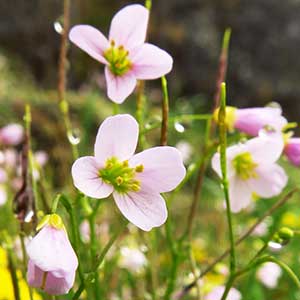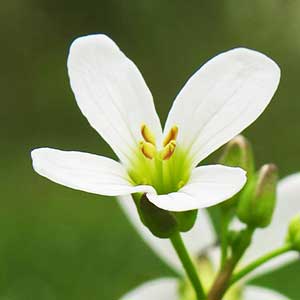Cardamine pattersonii
Cardamine penduliflora
Saddle Mountain bitter-cress
wetlands bitter-cress, Willamette Valley bitter-cress
cylindrical, slender, 0.5–1.5 mm diam.
(tuberiform, fragile), 4–9(–11) mm diam., (fleshy).
(simple from base), erect, (not flexuous), unbranched or branched basally, 0.6–3 dm.
erect or decumbent at base, unbranched, 2–6(–7.5) dm.
rosulate or not, 3 or 5-foliolate, 1–6 cm, leaflets petiolulate;
petiole 0.4–2.5 cm;
lateral leaflets similar to terminal, considerably smaller;
terminal leaflet (petiolule 0.1–0.4 cm), blade obovate to orbicular or subcordate, 0.3–1.5(–2.0) cm × 2.5–16(–18) mm, base obtuse to rounded or cordate, margins entire or dentate to slightly sinuately lobed.
5–13-foliolate, (4–)10–18(–25) cm, leaflets petiolulate or subsessile;
petiole (3–)5–12(–17) cm;
lateral leaflets subsessile, blade similar to terminal, sometimes smaller;
terminal leaflet (petiolule 0.4–0.7 cm), blade oblong to elliptic or ovate, (0.4–)0.7–1.7(–2) cm, base cuneate or obtuse, margins entire or obscurely 3-lobed.
2–4, 3 or 5-foliolate, blade similar to basal, gradually reduced in size as bract, distalmost ones subtending pedicels of flowers (usually simple);
leaflet blade or bract linear to linear-oblanceolate, 0.2–0.8 cm.
2–6, 5–11-foliolate, petiolate, leaflets petiolulate or sessile;
petiole 3–10 cm, base not auriculate;
lateral leaflets sessile, blade similar to terminal, smaller;
terminal leaflet (petiolule 0.5–1.5 cm), blade narrowly ovate or oblong to oblanceolate, 1.5–3.5 cm × 2–15 mm, margins entire or toothed to 3-lobed.
bracteate throughout.
ebracteate.
sepals oblong, (2–)3 × 0.7(–1) mm, lateral pair not saccate basally;
petals purple or pink, obovate, 6–9 × 3–4 mm, (not clawed);
filaments: median pairs 3–3.5 mm, lateral pair 2–2.5 mm;
anthers oblong, 0.7–1 mm.
sepals oblong to ovate, 3.5–5 × 1.8–2.5 mm, lateral pair saccate basally;
petals white, obovate, 12–16 × 6–8 mm, (not clawed, apex rounded or subemarginate);
filaments: median pairs 6–7 mm, lateral pair 4–5 mm;
anthers oblong, 1.5–1.8 mm.
divaricate-ascending, (10–)15–30(–45) mm.
ascending to divaricate, (10–)20–40(–60) mm.
linear, (torulose), 2–3 cm × 1–1.5 mm;
ovules 14–20 per ovary;
style 2–4 mm.
linear, 2.5–4.5 cm × 1.4–2 mm;
ovules 12–24 per ovary;
style 4–6 mm.
brown, oblong to ovoid, 1.7–2.2 × 1–1.5 mm, (winged distally).
brown, oblong, 1.8–2 × 1–1.5 mm.
Cardamine pattersonii
Cardamine penduliflora
Of conservation concern.
Cardamine pattersonii is known from Saddle Mountain and Onion Peak in Clastop County.
(Discussion copyrighted by Flora of North America; reprinted with permission.)
Cardamine penduliflora is known from Douglas County north into Benton, Lane, Marion, Polk, and Yamhill counties.
(Discussion copyrighted by Flora of North America; reprinted with permission.)



